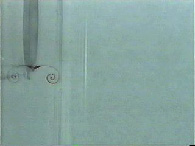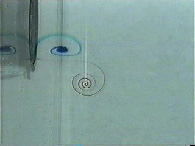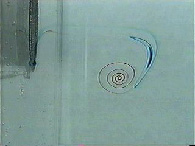Interaction of a ring vortex with a piston vortex
The process of vortex ring generation and propagation has received substantial treatment in the literature. A common ring generation geometry consists of a piston moving through tube that exits into a tank through a circular orifice in a normal wall. This paper investigates the effect of the vortex that forms in front of the piston on the primary vortex that is formed at the tube exit. It is shown that when the piston finishes its stroke flush with the wall the piston vortex interacts with the primary vortex. Experiments reveal that the piston vortex can have a significant effect on the trajectory of the primary vortexRecent studies on vortex ring generation, e.g. Rosenfeld et al. (1998), have highlighted the subtle effect on generation geometry on the final properties of rings. Experimental generation of vortex rings often involves moving a piston through a tube, resulting in a vortex ring being generated at the tube exit. A generation geometry that has been cited as a standard consists of the tube exit mounted flush with a wall with the piston stroke ending at the tube exit, Glezer (1988). We employ this geometry to investigate the effect of the vortex that forms in front of the advancing piston (piston vortex) on the primary vortex ring that is formed at the tube exit. It is shown that when the piston finishes its stroke flush with the wall, and hence forms an uninterrupted plane, the piston vortex is convected through the primary ring and then ingested into the primary vortex. The ingestion of the piston vortex results in an increased ring impulse and an altered trajectory, when compared to the case when the piston motion is finished piston speed and piston diameter, is the order of three thousand, transition to turbulence is observed during the self-induced translation phase of the ring motion. Compared to the case when the piston is stopped inside the tube, the vortex ring which has ingested the piston vortex transitions to turbulence at a significantly reduced distance from the orifice exit and suggests the transition map suggested by Glezer (1988) is somewhat under question. A secondary instability characterized by vorticity filaments with components in the axial and radial direction, was observed forming on the piston vortex. The structure of the instability appears to be similar to the streamwise vortex filaments that form in the braid regions of shear layers This instability was subsequently ingested into the primary ring during the translation phase and may act to accelerate the growth of the Tsai-Widnall instability. It is suggested that the origin of the instability is Görtler in nature and the result of unsteady wall jet nature of the boundary layer separating on the piston face.


